Schalke 04 was one of Germany’s first truly working class football clubs. Players and fans came from the same town – Gelsenkirchen – and most from the Schalke district itself. This is where the miners and their families lived, worked and played. The club’s first stadium – the Glückauf-Kampfbahn – was built here. The triumphs of the 1920s and 1930s were celebrated on these streets. On match days the road from the Schalker Markt to the ground was a sea of blue and white.
Since then much has changed. De-industrialisation has brought the district into steep decline. The community of old is no more and the area has a run down feel to it. The club moved three kilometres to the north many years ago – first to the Parkstadion and then into the shiny new Veltins Arena. Now just the unremarkable suburb of an industrial city, it’s hard to imagine what it must have been like here during Schalke’s glory days.
But many fans still cherish Schalke’s roots. They remember that Schalke is a place as well as a club. They lament the fact that you can support the modern Schalke 04 without ever setting foot in the part of town whose name the club carries, and without knowing about its origins and history.
Fan Project Schalker Meile
In 2006 a a group of fans got together to do something about this – to make sure that this part of town and it history are not forgotten. They wanted to create a second royal blue haven.
And so the project Schalker Meile was born. The idea was fill a stretch of the road between the old Schalker Markt and the original Glückauf stadium – the route once walked by hundreds of thousands of fans – with as many reminders of Schalke 04 as possible.
Electricity pylons were painted in the club colours and empty shop windows decorated with signs. Banners and posters were put up. Local businesses were encouraged to adapt their branding to make reference to the club. The tram stop in the middle was renamed ‘Schalker Meile’ and the entire street was transformed into a blue and white tribute to Schalke, with key historic buildings signposted.
The main sights
In the m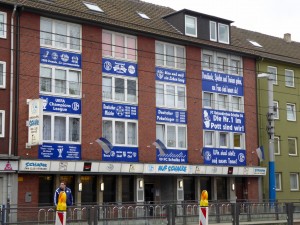 iddle there is a pub called ‘Auf Schalke’ which is run by the Schalke fan club (90,000 members),
iddle there is a pub called ‘Auf Schalke’ which is run by the Schalke fan club (90,000 members),
and there is a fan shop nearby.
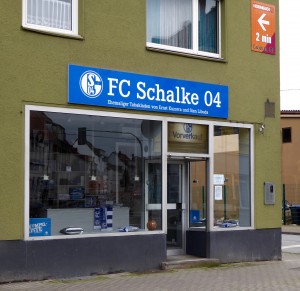
A bit further along you pass the tobacconist shop which until 1974 was run by former player Ernst Kuzorra, and then was taken over by another Schalke legend – Stan Libuda.
Towards the end of the Meile and right next to the old stadium there is another pub called ‘das 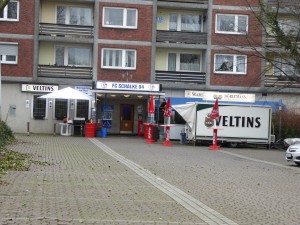 Bosch’. This is where the players used to drink. A sign indicates Ernst Kuzorra’s regular seat. It’s now the home of a fan group called ‘Kuzorras grandchildren’, as well as pub of choice on match days of countless Schalke fans.
Bosch’. This is where the players used to drink. A sign indicates Ernst Kuzorra’s regular seat. It’s now the home of a fan group called ‘Kuzorras grandchildren’, as well as pub of choice on match days of countless Schalke fans.
And finally you arrive at the old Glückauf-Kampfbahn. Although looking sadly run down, it is still in use for youth games, and still undoubtedly ‘Schalke’.
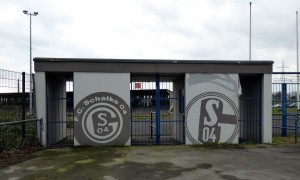
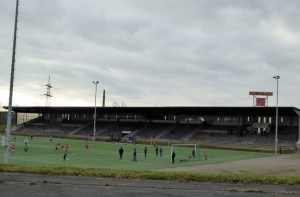
The yellow house appears
The impact of this tribute to Schalke’s past and present is huge. Thousands of people travel up and down this street every day. On match days, trams and buses take fans along it on their way to and from Veltins Arena. Many stop off for a while to have a drink with friends. It has become a place of pride for residents and visitors alike.
So it is easy to imagine the dismay when, in April 2015, one of the biggest buildings, right in the middle, almost opposite the Auf Schalke pub, was painted bright yellow – the colour of arch rivals Dortmund.
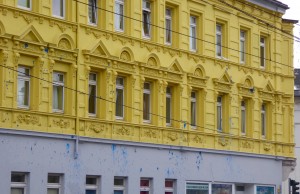 More reasonable fans suggested that, as the owner was from Holland, he might have not understood the implications of his choice of colour. But others were outraged and later the same year the building was daubed in blue and white paint. Again, local reaction was mixed. Some people argued that any attack on private property was wrong, others that as every other surface had elements of blue and white it was only to be expected.
More reasonable fans suggested that, as the owner was from Holland, he might have not understood the implications of his choice of colour. But others were outraged and later the same year the building was daubed in blue and white paint. Again, local reaction was mixed. Some people argued that any attack on private property was wrong, others that as every other surface had elements of blue and white it was only to be expected.
What next?
Everyone agrees that the current situation cannot continue. It’s hard to see, however, how things can be resolved. The owner is completely within his rights to paint the building yellow, but even the most mildest, reasonable of local people are very upset at the impact of this building on their street.
The solution might lie in the club’s origins. The very first Schalke team from 1904 wore yellow and red shirts – so maybe a sensible compromise would be to paint the lower half of the building red and agree that the colours are a gesture to the club’s founders.
